TRADE SECTION - TECHNICAL SPECIFICATIONS
In the mid 90’s, we began to import these diamonds to America, we realized that branding was an expensive and time-consuming venture. We believed these incredible diamonds, known in the trade as “Hearts and Arrows” could stand on their own merit, without a fancy name, based simply on their sheer beauty & perfection in cutting. Shakespeare said: “That which we call a rose, by any other word would smell as sweet." Years later, these diamonds have become the foundation of more than a dozen diamond brands with names connoting love and romance and containing words like: Hearts, Arrows, Love, Cupid, etc.
As jewelers began to offer these diamonds in America they did not have to choose between selling the “sizzle or the steak”...these diamonds had both!
These spectacularly beautiful diamonds out shined the competition, scored the highest grades in light performance, garnered the top cut grades in leading gem labs and finally that ‘cool hearts and arrows pattern” simply was “the exclamation point” on an already exciting story.
Take a closer look at Hearts & Arrows...
The DNA of Hearts & Arrows
The five main components involved in creating a Hearts and Arrows Ideal are summarized below. It is assumed that the diamond must be very round and have exceptional symmetry. It should be understood that excellent polish and symmetry alone is not enough to qualify for H&A status. Cutting Hearts and Arrows is very difficult. The H&A pattern is quite sensitive to symmetrical imperfections. Because of the high degree of symmetry and the limited proportion sets for which the patterns are visible, cutters often settle on cutting for GIA Excellent or some other premium cut instead of committing the time and weight loss necessary to produce a super ideal H&A diamond. Exceptional Optical Symmetry created by these five component parts working together in harmony is responsible for the diamond’s exceptional light performance as well as the sharp, well-formed Hearts and Arrows pattern.
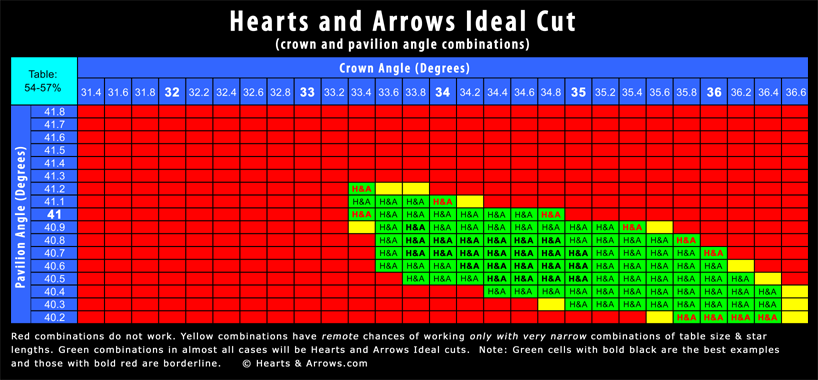
Fig CH-1
Fig CH-2 below shows the parts of the diamond that must work in harmony when manufacturing H&A diamonds.
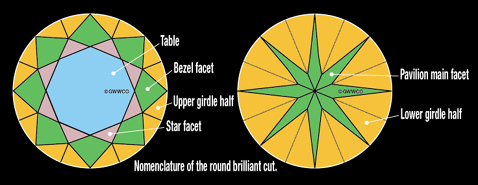
Fig CH-2
1.) Pavilion Angle
Pavilion Angle: range 40.2° - 41.2° (40.6° - 40.8° is optimum)
The most important factor in light performance in diamonds is proper bottom angles. Tolkowsky sighted pavilion angles of 40.75° and modern optical science has confirmed these angles to be mathematically sound. The pavilion main facets are like eight mirrors all angled in such a way to reflect light that enters a diamond at vertical angles from 0° to 15° from it’s axis. When the pavilion main facets of a diamond are angled too steep, they will not reflect maximum light back to the viewer. In fact, when these angles exceed 41°, the shaft part of the arrows begins to disappear. It is difficult to have bright evenly colored arrows in the H&A viewer, as these facets are beginning to reflect off the walls of the viewer instead of the white ring at the top. “Angle symmetry”, which refers to all of the facets of a group being cut at the same angle, is imperative in maintaining optical symmetry, so that all eight arrows “light-up” at the same time. Fig B-1
See crown and pavilion combinations chart above Fig CH-1
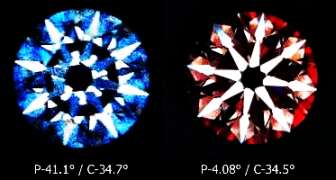
Fig B-1
2.) Crown Angle
Crown angle: range 33.4° - 36.4° (34° - 35° is optimum)
The crown angle works in harmony with the pavilion angle. If the pavilion angle is slightly steeper than optimum, a shallower crown angle must compensate for this. Conversely, a shallow pavilion angle can be balanced with a slightly steeper crown angle. However, a combination of a steep crown angle and a steep pavilion angle creates problems and would never be found in an H&A stone. For reasons like this, the AGS laboratory abandoned their “legacy” proportion system for their present light performance method. A good illustration of this is shown in the following example: A diamond with a 41.1° pavilion angle coupled with the 35° crown angle would have garnered an AGS 0 proportion grade, but has no chance for H&A due to the combination of pavilion and crown angle. The chart Fig CH-1 above shows crown angles that work in combination with specific pavilion angles that are imperative to creating bright H&A patterns while delivering superior light performance.
3.) Table Size
Table Size: 53% To 58% (54%-57% is optimum)
The table size of a diamond affects both light performance and H&A pattern. In the arrows view, the table size affects the size of the table reflection (star) in the center of the stone at the culet. Fig B-6 It also affects the shape of each of the eight hearts by rounding off the shoulders of each heart. Fig B-5 Shows how the heart’s shoulders are squared-off and improved by the smaller table.
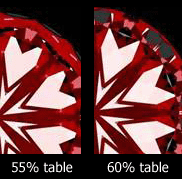
Fig B-5
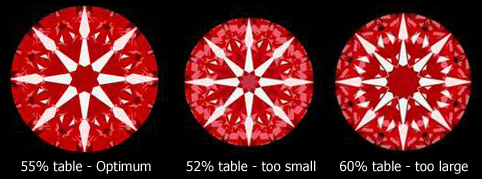
Fig B-6
4.) Lower Girdle Halves
Lower Girdle Halve length: 75% To 80% (77% is optimum)
The real secret to the Hearts and Arrows pattern lies in the creation of these 16 facets of the pavilion. This parameter is crucial in the process of creating the heart shapes. These carefully placed facets produce the eight pavilion mains that are the foundation on which both the hearts and arrows are created. It is imperative that all lower girdle halves are cut to exactly the same length and angle, or the resultant pavilion mains will vary in size and shape and will create crooked hearts and crooked arrows. Fig B-8

Fig B-8
5.) Star Facets
Star Facet Length: 40% To 58% (45%-50% is optimum)
Star facet length is a little known factor in brillianteering that can impact the hearts or arrows pattern. In the heart view, the star facets round off the shoulders or lobes of the hearts, which directly relates to the size of the table. In the arrows view, each star facet contains two small pairs of triangles that are visible between the eight arrowheads. Fig B-9 Long star facet lengths will create problems in cutting the Hearts and Arrows Ideal. If the star facets are too long, they will create the negative effect called “clustering and interference figures”. This disturbs the typical pattern of the arrowhead and shaft area of the eight arrows by adding white reflections that alter the normal H&A pattern. Fig B-10
“Clustering” or interference figures can be exaggerated by a combination of long star facets >55%, lower girdle halves >77% along with steeper pavilion angles. This negative factor makes the arrows pattern unacceptable as shown in Fig B-11. The “perfect arrows view” below is much cleaner in appearance due to star facets that fall between 45%-50%. Fig B-12
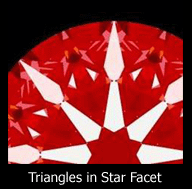
Fig B-9
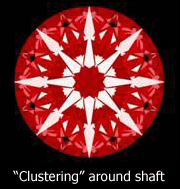
Fig B-10
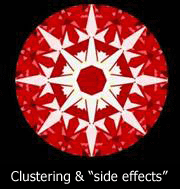
Fig B-11
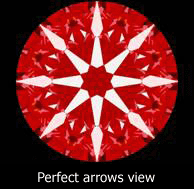
Fig B-12